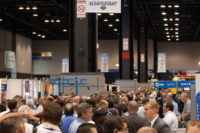Not too hot, not too cold

One could make a strong case that the invention of the emergency shower and eyewash were among the greatest advancements in industrial employee safety in the past 60 years. In fact, it’s difficult to imagine how we operated prior to their introduction. They certainly revolutionized employee and employer peace-of-mind in hazardous material environments, to say the least. Those early system designs, however, did not largely take into account the comfort and, to a point, the safety of the people who used them. Exposure to the significant volumes of water used in this equipment during a full-duty cycle can be uncomfortable and even dangerous, if it is outside of a specific temperature range – either too cold or too warm.
More recently, the science of emergency equipment design and application has begun to more stringently recognize that temperature range. For the past several years, water temperatures below about 80°F (26°C) have begun being addressed through Engineered Solutions™ referred to as “Tempered Water” packages. Using sophisticated, self-contained monitoring capabilities, tempered water systems blend hot and cold input water to maintain a prescribed temperature through a full duty cycle. The best of these systems also provide a guard-band measure that by-passes the blending configuration in the event of either a cold or hot water input failure. This eliminates the possibility of scalding, while also assuring the availability of some degree of shower use if at all possible.
Before we go any further, we should discuss the specific high and low limits of the temperature range. The ANSI official range limits are any input water below 60°F would require tempering (warming) and any input water exceeding 100°F would require reverse tempering (cooling).
While much attention has been paid to tempered water not nearly as much has focused on reverse tempering.
Solutions for hot showers in severe climates
As mentioned, colder climates with cold input water conditions can have a serious effect on emergency equipment operation and user comfort. Emergency equipment manufacturers have through the years designed equipment and option packages that address the lower limits of the operating temperature range. But, as severe as cold climate conditions can be, summer or hot climate conditions can produce excessively high water temperatures at the safety equipment.In warmer regions of the world, it is common to experience water temperatures in excess of 100° F (38°C). At those temperatures, it is possible for the hot water to amplify the burning pain associated with a chemical exposure, for example. When input water temperatures become a concern, there are several options to cool things down.
OPTION 1: Hot water at shower piping,
(Example: Above ground piping, exposed to direct sunlight in Houston, Texas)In facilities where the safety shower supply piping is exposed to extreme ambient temperatures, but the ground supply temperature is lower, we specify a central chilling package that serves a safety shower loop. This provides a package that contains the chiller equipment and a recirculation pump to continuously chill the loop water. The recirculation pump moves the water throughout the loop at a low flow rate, which passes it through the central chiller to drop the water down from the ambient temperature to 80°F (26°C). This process continues throughout the day until the ambient temperatures have no effect on the loop, at which time the system stops the chilling process.
OPTION 2: Hot water at shower, and
(Example: Shower and/or eyewash installation in Saudi Arabia)This scenario is the same as above, but now when a shower is activated, the incoming supply is also hot. To combat this, a storage tank will be included in the package, sized for the number of safety showers operating simultaneously. The storage tank will be in-line with the chiller so that the recirculation pump will push the chilled water through the tank and out to the safety showers. You now have a safety shower loop that is maintained at a comfortable level with a storage capacity large enough to supply your shower or showers. Now as a shower is activated the user will be guaranteed a cool and comfortable shower for the required 15 minute-drench.
OPTION 3: Other solutions
(Examples: A semi-portable, self-contained (closed) system or an air-charged system or an application calling for a climate-controlled booth)While many requests deal with supply water heated by nearby industrial processes or pipes exposed to the sun (option #1) or simply a hot water supply in a hot climate (option #2), there are other specific needs and one-off applications that can be encountered.
For instance, in either of the first two options the required chiller would most likely be centralized to feed cool water to several showers and/or eyewashes. Alternatively, a semi-portable single shower application might feature a closed loop system, designed with a smaller chiller and re-circulation pump integrated into its design. The same approach might be appropriate for an air-charged, closed loop system used in a remote location. And, under certain circumstances, housing an entire stand-alone shower system in a climate-controlled enclosure might be the best approach. The point is that there are many ways to address reverse tempering challenges. The “best” one is the one that works best for you.
Looking for a reprint of this article?
From high-res PDFs to custom plaques, order your copy today!





